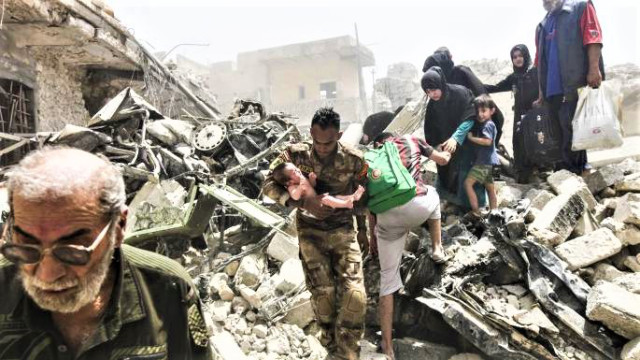 Award-winning journalist Patrick Cockburn, Middle East correspondent of The Independent, writes from Mosul, recording accusations by local people who assert the US-led coalition has ‘massively’ overused force.
Award-winning journalist Patrick Cockburn, Middle East correspondent of The Independent, writes from Mosul, recording accusations by local people who assert the US-led coalition has ‘massively’ overused force.
They allege that the intensity of the bombardment from the air was out of all proportion to the number of Isis fighters on the ground
Though they agreed that Isis forced people into houses in combat zones and murdered them if they tried to flee, they added that the sight of a single sniper on a roof would lead to bombing the whole building, killing the sniper and the families living inside.
“There were very few Daesh in our neighbourhood, but they dropped a lot of bombs on them,” says Qais, 47, a resident of the al-Jadida district of Mosul. “We reckon that the airstrikes here killed between 600 and 1,000 people.” He shows pictures on his phone of a house that had stood beside his own before it was hit by a bomb or missile that had reduced it to a heap of smashed-up bricks. “There were no Daesh in the house,” says Qais. But there were seven members of the Abu Imad family living there, of whom five were killed along with two passers-by.

Cockburn reports that a sign that Isis was not present in any numbers is that, while there are bombed out buildings in every street, there are surprisingly few bullet holes in the walls from automatic rifles or machine guns. In cities like Homs in Syria today or Beirut during the civil war, wherever there had been street fighting of any intensity, walls were always pock-marked with bullet holes.
The offensive against Isis in Mosul has left thousands of buildings destroyed. Nobody knows how many civilians died in Mosul because many bodies are still buried under the rubble in 47 degrees heat. Asked to estimate how many people had been killed in his home district of al-Thawra, Saad Amr, a volunteer medic, said: “we don’t know because houses were often full of an unknown number of displaced people from other parts of the city. Some districts are so badly damaged that it is impossible to reach them. We heard that there had been heavy airstrikes on the districts of Zanjily and Sahba and, from a distance, we could see broken roofs with floors hanging down like concrete flaps. But we could not get there in a car because the streets leading to them were choked with broke masonry and burned out cars”.
Amnesty International’s report, The Civilian Catastrophe in West Mosul, says bombardments by Iraqi and US-led coalition forces killed a “huge number” of civilians. On 17 March 2017 a US airstrike on the Mosul al-Jadida neighbourhood killed at least 105 civilians in order to neutralise two Isis snipers. It calls for an investigation by an independent commission into the number of civilian deaths caused by ISIS strategies and US airstrikes.
–
Today in the Times:
| Hopes of finding life in Mosul’s Old City are fading |
 |
| A small rescue team of underequipped Iraqis, operating without support from the coalition or international disaster response agencies, is struggling to save those few survivors still trapped in the wreckage and raise the bodies for proper burial. |
–
Patrick Cockburn delivered this year’s Nick Lewis Memorial Trust Lecture at Cardiff University: https://www.cardiff.ac.uk/news/view/741493-foreign-correspondent-patrick-cockburn-to-deliver-guest-lecture
Read his article here: http://www.independent.co.uk/news/world/middle-east/isis-baghdadi-mosul-air-strikes-civilians-killed-us-a7836261.html
b
Advertisements Share this:





